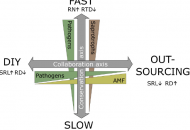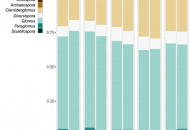Featured
-
Deciphering nature’s climate shield: Plant diversity stabilises soil temperature
Based on a media release of Leipzig University A new study has revealed a natural solution to mitigate the effects of climate change, such as extreme weather events. Researchers from…
-
New publication from Eisenhauer et al. in npj Biodiversity: Reply: Functional similarity is more appropriate than functional redundancy
Replying to Felícia M. Fischer and Francesco de Bello npj Biodiversity https://doi.org/10.1038/s44185-023-00029-z (2023) In our Comment, we outlined that the term functional redundancy (1) may have been overused from an…
-
New publication from Ristok et al. in Ecology and Evolution: Plant diversity and soil legacy independently affect the plant metabolome and induced responses following herbivory
Plant and soil biodiversity can have significant effects on herbivore resistance mediated by plant metabolites. Here, we disentangled the independent effects of plant diversity and soil legacy on constitutive and…
-
Subproject Z1: Coordination (1 Technical Assistant position)
Principle Investigators: Gerd Gleixner, Max Planck Institute for Biogeochemistry, Jena, Germany Summary: In the Jena Experiment, the influence of biodiversity on element cycling is investigated. For the long-term observation of…
-
The Jena Experiment is seeking PhD students, postdoctoral researchers and technical staff
Within the DFG Research Unit FOR 5000 (Biotic interactions, community assembly, and eco-evolutionary dynamics as drivers of long-term biodiversity–ecosystem functioning relationships), nine four-year PhD positions, a three-year postdoctoral position, and…
-
Funding new research in the Jena Experiment – focus on ecosystem stability
Deutsche Forschungsgemeinschaft (DFG) to fund Research Unit for another four years Joint media release from iDiv, Leipzig University and Friedrich Schiller University Jena Jena/Leipzig. The Deutsche Forschungsgemeinschaft (DFG) is to…
-
New publication from Hennecke et al. in New Phytologist: Responses of rhizosphere fungi to the root economics space in grassland monocultures of different age
Recent studies on root traits have shown that there are two axes explaining trait variation belowground: the collaboration axis with mycorrhizal partners and the conservation (‘fast – slow’) axis. However,…
-
New publication from Pinheiro Alves de Souza et al. in Microbial Ecology: Deterministic development of soil Microbial communities in disturbed soils depends on microbial biomass of the bioinoculum
Despite its enormous importance for ecosystem services, factors driving microbial recolonization of soils after disturbance are still poorly understood. Here, we compared the microbial recolonization patterns of a disturbed, autoclaved…
-
New publication from Albracht et al. in Frontiers in Soil Science: Effects of recurrent summer droughts on arbuscular mycorrhizal and total fungal communities in experimental grasslands differing in plant diversity and community composition
Introduction: Biodiversity loss and climate change have been determined as major global drivers affecting ecosystems and their functioning. In this context, drought was shown to have negative effects on ecosystems…
-
Jäthelfer (w/m/d) gesucht vom 09.10. – 29.10.2023
#English version below# Ihr interessiert euch für Pflanzen und arbeitet gerne draußen? Wir brauchen Hilfe bei der Instandhaltung der Versuchsflächen des Jena Experiments! Hintergrund: Das Jena-Experiment befasst sich mit der…
Posts navigation
We’ve made the move from Twitter to Bluesky. Follow us there for all the latest updates.











